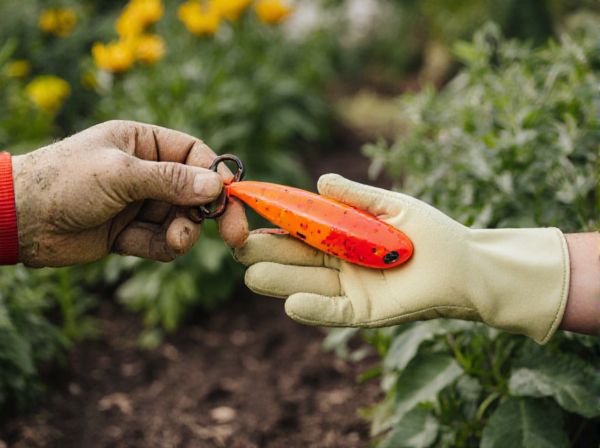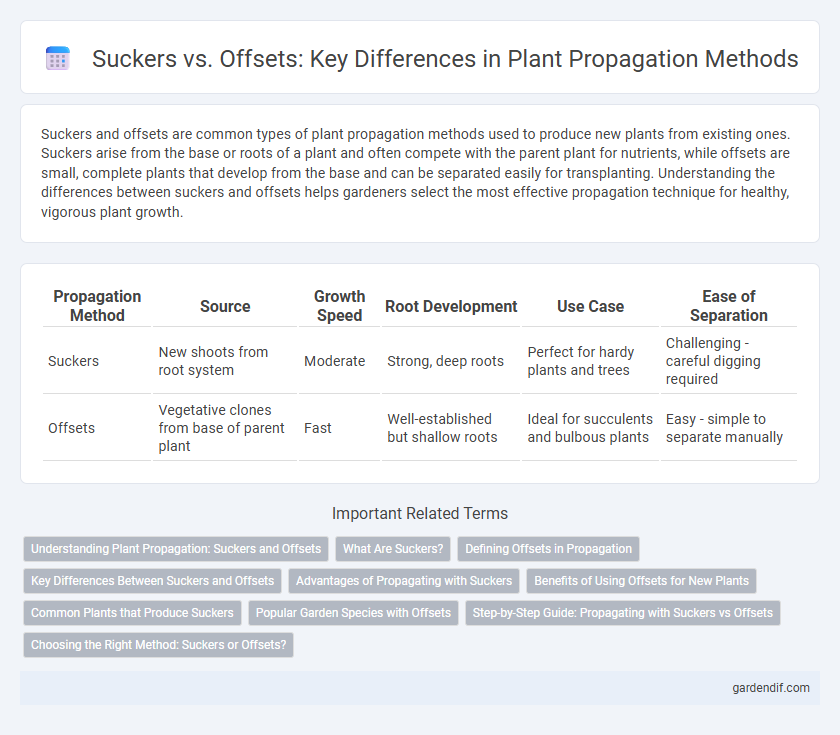
Suckers vs Offsets Illustration
Suckers and offsets are common types of plant propagation methods used to produce new plants from existing ones. Suckers arise from the base or roots of a plant and often compete with the parent plant for nutrients, while offsets are small, complete plants that develop from the base and can be separated easily for transplanting. Understanding the differences between suckers and offsets helps gardeners select the most effective propagation technique for healthy, vigorous plant growth.
Table of Comparison
| Propagation Method | Source | Growth Speed | Root Development | Use Case | Ease of Separation |
|---|---|---|---|---|---|
| Suckers | New shoots from root system | Moderate | Strong, deep roots | Perfect for hardy plants and trees | Challenging - careful digging required |
| Offsets | Vegetative clones from base of parent plant | Fast | Well-established but shallow roots | Ideal for succulents and bulbous plants | Easy - simple to separate manually |
Understanding Plant Propagation: Suckers and Offsets
Suckers and offsets are two common forms of vegetative propagation used to create new plants from existing ones. Suckers arise from the roots or base of a parent plant, producing vigorous shoots that can be separated and planted independently, commonly seen in fruit trees and shrubs. Offsets are small, complete daughter plants that grow from the base or leaf axils of the mother plant, typical in succulents and bulbs, enabling rapid and reliable propagation.
What Are Suckers?
Suckers are vigorous shoots that emerge from the base or roots of a plant, often around the root collar. They arise from adventitious buds and can grow rapidly, diverting energy away from the main stem, which may weaken the overall plant structure. In propagation, suckers are sometimes removed to maintain plant health, but they can also be used to produce new plants through vegetative propagation.
Defining Offsets in Propagation
Offsets are small, genetically identical plants produced from the base of a parent plant, enabling asexual propagation for rapid colony formation. These miniature clones develop roots while still attached, facilitating easy separation and replanting without affecting the parent. Offsets are commonly used in succulent and bulbous plant species to maintain desirable traits and ensure uniform growth.
Key Differences Between Suckers and Offsets
Suckers and offsets are two types of plant propagation structures differing primarily in their origin and growth patterns. Suckers arise from the root system near the base of the parent plant and can develop into new plants when separated, while offsets are short, horizontal stems or buds that grow from the parent plant's base or along roots and form independent plants. Understanding these key differences helps gardeners choose the most effective method for cloning and spreading specific plant species.
Advantages of Propagating with Suckers
Propagating with suckers offers faster establishment and stronger root systems compared to offsets, resulting in more vigorous and resilient plants. Suckers inherit the genetic traits of the parent plant, ensuring consistent growth and higher survival rates in diverse soil conditions. This method is particularly advantageous for fruit trees and shrubs, as it promotes better nutrient absorption and increased overall plant health.
Benefits of Using Offsets for New Plants
Offsets provide a quicker and more reliable method for propagating new plants compared to suckers, as they are naturally detached plantlets that develop from the base of the parent plant. Using offsets ensures genetic consistency and reduces the chances of disease transmission, promoting healthier growth in new plants. Their ease of separation and establishment enhances propagation efficiency, making them ideal for gardeners seeking uniformity and faster maturation.
Common Plants that Produce Suckers
Common plants that produce suckers include raspberries, blackberries, and hawthorns, which send up new shoots from their root systems to propagate vegetatively. These suckers enable rapid colony expansion and are often used to produce new plants identical to the parent. Managing suckers is essential in gardens and orchards to prevent unwanted spread and maintain plant health.
Popular Garden Species with Offsets
Popular garden species with offsets include Aloe vera, Agave, and Spider plants, which produce small plantlets or clones around the base for easy propagation. Offsets ensure genetic consistency and faster growth compared to suckers, which arise from underground shoots or roots, often requiring more care to establish. Gardeners favor offsets for their reliability and minimal disturbance to the parent plant during propagation.
Step-by-Step Guide: Propagating with Suckers vs Offsets
Propagating with suckers involves carefully digging around the base of the parent plant to identify and detach young shoots emerging from the root system, ensuring each sucker has its own roots for successful transplantation. Offsets propagation requires removing small, fully-formed plantlets growing at the base or near the parent plant, trimming dead roots, and planting them in well-draining soil to encourage independent growth. Both methods demand proper soil preparation, watering routines, and monitoring for root development to maximize propagation success and plant health.
Choosing the Right Method: Suckers or Offsets?
Choosing between suckers and offsets for propagation depends on the plant species and desired growth characteristics. Suckers, emerging from roots or basal shoots, often produce vigorous plants with deep rooting systems, ideal for fruit trees and shrubs. Offsets, small clones growing adjacent to the parent plant, are preferable for succulents and bulbs due to their faster establishment and uniform genetic traits.
Suckers vs Offsets Infographic

 gardendif.com
gardendif.com